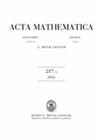随机正则图上的最大独立集
IF 6.7
1区 数学
Q1 MATHEMATICS
引用次数: 60
摘要
我们确定了所有$${d\geq d_0}$$ d≥d0的随机d正则图的独立数的渐近性。它是高度集中的,对于显式常数$${\alpha_*(d)}$$ α∗(d)和$${c_*(d)}$$ c∗(d),在$${n\alpha_*-c_*\log n}$$ nα∗-c∗logn附近具有常阶波动。我们的证明严格地证实了该问题的一步复制对称破断启发式,我们相信该技术将更广泛地适用于随机图的其他组合性质的研究。本文章由计算机程序翻译,如有差异,请以英文原文为准。
Maximum independent sets on random regular graphs
We determine the asymptotics of the independence number of the random d-regular graph for all $${d\geq d_0}$$d≥d0. It is highly concentrated, with constant-order fluctuations around $${n\alpha_*-c_*\log n}$$nα∗-c∗logn for explicit constants $${\alpha_*(d)}$$α∗(d) and $${c_*(d)}$$c∗(d). Our proof rigorously confirms the one-step replica symmetry breaking heuristics for this problem, and we believe the techniques will be more broadly applicable to the study of other combinatorial properties of random graphs.
求助全文
通过发布文献求助,成功后即可免费获取论文全文。
去求助
来源期刊

Acta Mathematica
数学-数学
CiteScore
6.00
自引率
2.70%
发文量
6
审稿时长
>12 weeks
期刊介绍:
Publishes original research papers of the highest quality in all fields of mathematics.
 求助内容:
求助内容: 应助结果提醒方式:
应助结果提醒方式:


